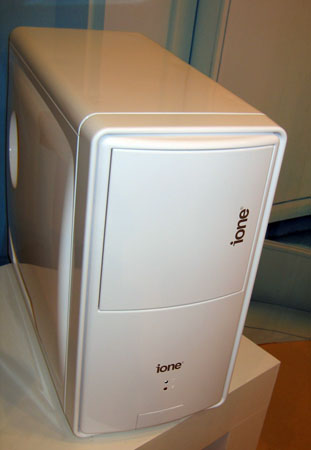Computex 2005 - Day 3 Tidbits
by Kristopher Kubicki on June 1, 2005 11:06 PM EST- Posted in
- Trade Shows
MGE
Just about a year ago, we saw the first “Dragon” prototypes at Computex, but a year came and went and no retail cases ever came to the US. Apparently, there were some structural problems with the case and a revision had to be completed. The Dragon 2 aims to correct these problems, although some of the “wow” factor has definitely diminished.Another one of MGE’s new designs was the Ninja 2.
In the “prototype” section of MGE’s booth, we had a chance to look at MGE’s Ione line. Ione will be the second case lineup for MGE – a more reserved lineup primarily aimed at HTPCs.













35 Comments
View All Comments
KristopherKubicki - Friday, June 3, 2005 - link
Thanks for the update DoctorBooze. The details I got were just from a quick conversation with a VP at NetCell. It sounds like their tech is going to be on some motherboards in the near future, so hopefully by then I'll have more details.Kristopher
DoctorBooze - Friday, June 3, 2005 - link
Couple of points about all this RAID stuff. The RAID level described in the article is RAID 4, not RAID 3; RAID 3 uses byte-level striping, not block-level. RAID 3 needs synchronised spindles for adequate performance because, to read a whole block back, you have to read off all the discs except the parity disc. Most implementations will also read back the parity and make sure the data is valid; there's no performance hit for this. Overall, RAID 3 reads and writes about as fast as a single drive (whether you have validation enabled or not). It's a very safe way to store your data, as it'll pick up single-sector faults and correct for them (and the controller or OS can subsequently mark the block as bad with no harm done).RAID 4 and RAID 5 do not require synchronised spindles because they operate at a block level, so for any block of data you only have to read one disc, and if they validated the data, they'd be as slow as RAID 3 (because they'd have to read the contents of all the discs to retrieve and validate one block, which would mean you got none of the benefits of parallelism). RAID 4 and 5 only protect against faulty sectors if the drives report them as faulty rather than just returning duff data.
KristopherKubicki - Friday, June 3, 2005 - link
Re: All the comments about RAID5 - I may be a little biased, but the cannotation was *good* RAID5 support in kernel!Kristopher
KristopherKubicki - Friday, June 3, 2005 - link
JHutch: RAID3 is pretty much identical to RAID5 except that RAID3 dedicates a whole disk to parity.RyanVM: I might have phrased it incorrectly - but we meant to say don't expect to see a new card between X550 and R520.
Kristopher
fsardis - Friday, June 3, 2005 - link
is it just me or the new stacker 830 has 9 bays instead of 12? how can it be bigger than the original stacker then as mentioned in the article?LidlessEye - Friday, June 3, 2005 - link
Rebuild time shouldn't be quite that long... depending on other I/O and the RAID controller, I'm sure. But if there's a lot of I/O, you shouldn't be using ATA anyway... the probability of a failure even if it takes a day is miniscule. Also, since it wasn't pointed out in the article, RAID 10 or 0+1 offers much greater I/O and nearly the same fault tolerance for four disks, I would use 0+1 at 6 disks (instead of five in RAID 6). So that leaves RAID 6 for 7 or more drives... 14 is often cited as a "common" configuration. FWIW, EMC and IBM recommend RAID 10 and 5 in most of their SAN gear.USAF1 - Thursday, June 2, 2005 - link
@#25The other issue with RAID-3 is that all disks in the array are spindle synchronized. So, your I/O's per second are also limited to that of a single drive. By contrast, RAID-5 allows for independent control of all hard drives in the array. RAID-3 is great for streaming large, contiguous files but not much else. I have 18TB of CIPRICO RAID-3 devices where I work and I wish I didn't...
Doormat - Thursday, June 2, 2005 - link
Its coz rebuild time on a 10k or 15k 73GB SCSI HD is not that long. On an 8 drive 7200RPM 400GB(per drive) array, rebuild times are on the order of days.LidlessEye - Thursday, June 2, 2005 - link
oh... also, very few people use it in the server world since it so slow, and array failure due to two drive failures is generally caused by negligence, not rebuild time. I would never want to use it for a small array (<7 disks).LidlessEye - Thursday, June 2, 2005 - link
Windows has offered software RAID 5 since at least NT4. So it’s been available for about a decade…RAID 6 is worthless except in very large array sets (like 14 drives) for data archival mainly. Compaq (now HP) has offered this (Called RAID ADG) for about 5 years on their SCSI RAID controllers, and of course that’s in hardware. I believe IBM has offered it for a few years as well.